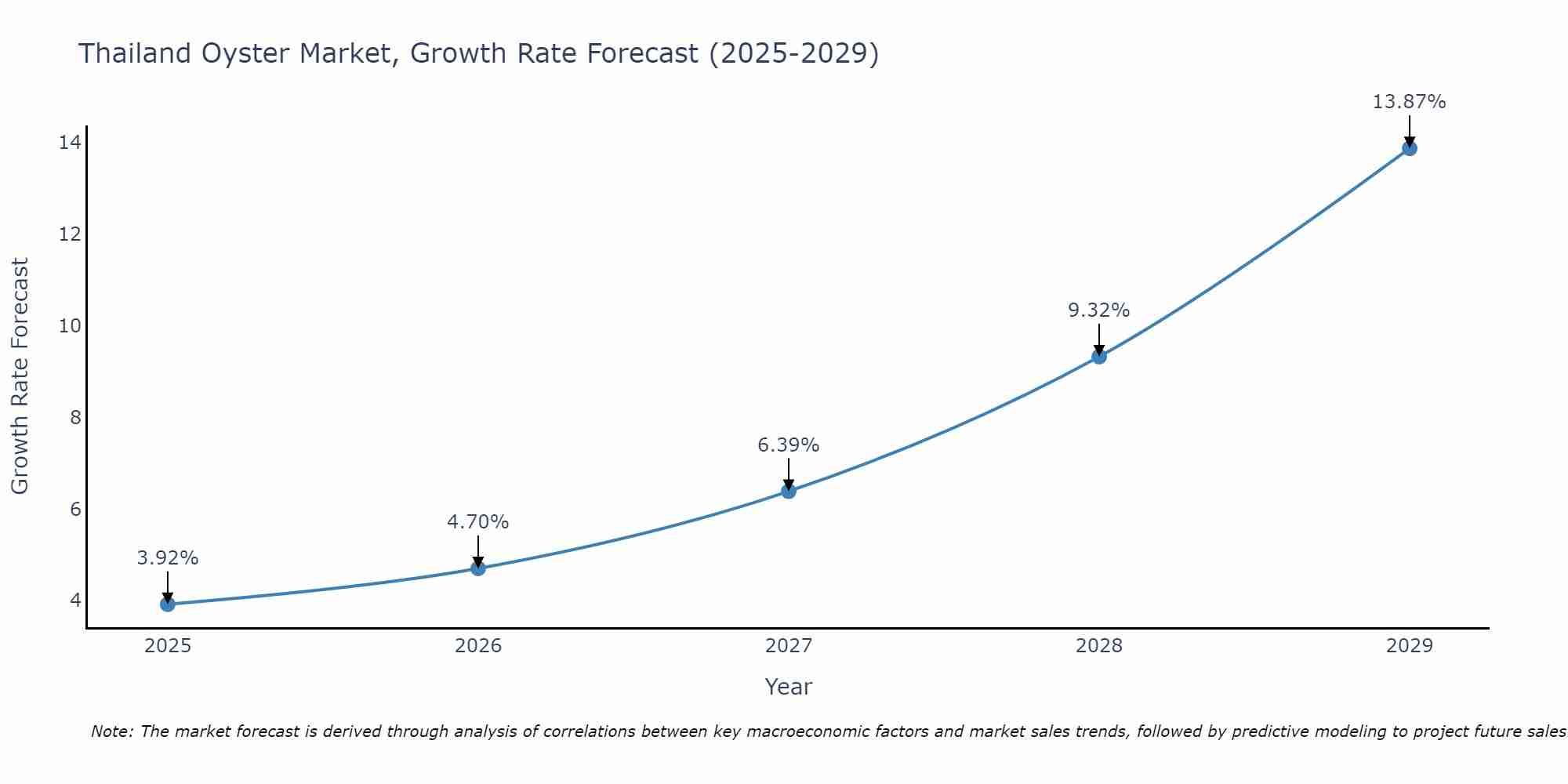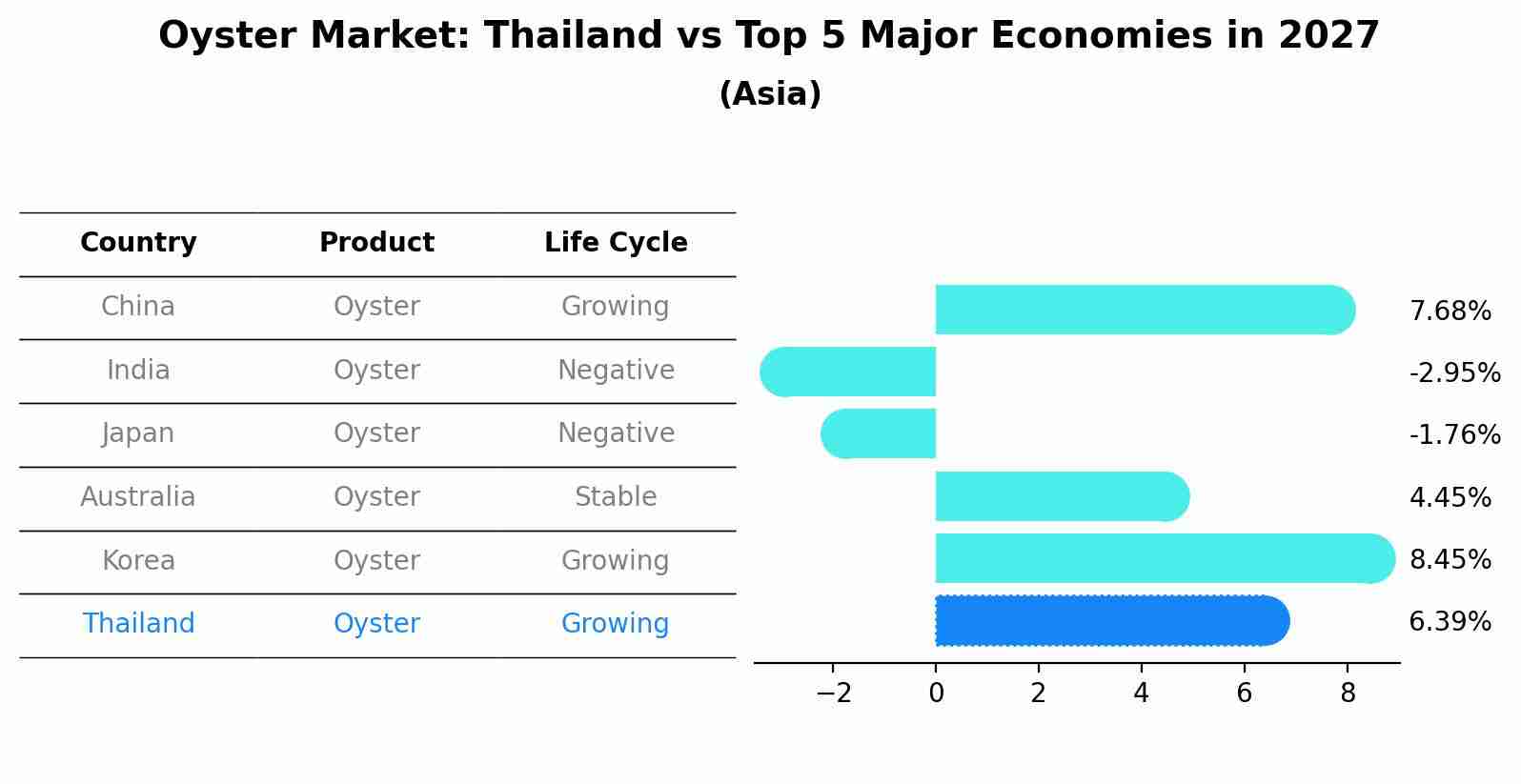Thailand Oyster Market (2025-2031) Outlook | Revenue, Companies, Analysis, Growth, Forecast, Trends, Share, Industry, Size & Value
| Product Code: ETC387505 | Publication Date: Aug 2022 | Updated Date: Apr 2025 | Product Type: Market Research Report | |
| Publisher: 6Wresearch | No. of Pages: 75 | No. of Figures: 35 | No. of Tables: 20 | |
Thailand Oyster Market Size Growth Rate
The Thailand Oyster Market is likely to experience consistent growth rate gains over the period 2025 to 2029. From 3.92% in 2025, the growth rate steadily ascends to 13.87% in 2029.

Oyster Market: Thailand vs Top 5 Major Economies in 2027 (Asia)
In the Asia region, the Oyster market in Thailand is projected to expand at a growing growth rate of 6.39% by 2027. The largest economy is China, followed by India, Japan, Australia and South Korea.

Thailand Oyster Market Synopsis
The Thai oyster market is flourishing, with a strong demand from both local consumers and international markets. Oysters are valued for their unique flavor and versatility in various culinary preparations. Restaurants, seafood markets, and exporters all play a significant role in driving the demand for oysters in Thailand. The market is characterized by a diverse range of oyster species, each offering distinct taste profiles, catering to the preferences of different consumer segments.
Drivers of the Market
The oyster market in Thailand is influenced by a combination of factors. Firstly, oysters are a beloved seafood delicacy in Thai cuisine, contributing to significant domestic consumption. Additionally, Thailand extensive coastline and suitable climate support oyster production, ensuring a consistent supply of fresh oysters to meet local demand. Furthermore, the international demand for Thai oysters has been on the rise due to their quality and taste, especially in Asian and European markets. Sustainable aquaculture practices have also become a driving force, as consumers and retailers increasingly seek responsibly sourced oysters. The focus on food safety and quality standards has further bolstered Thailand position as a key player in the global oyster market.
Challenges of the Market
The Thailand oyster market faces challenges similar to those of the oyster farming market, including concerns about product safety and consumer awareness. Ensuring the safety of oysters for consumption and promoting them as a delicious and nutritious seafood option is critical. Furthermore, competition from other seafood products may affect oyster demand, necessitating marketing efforts to increase their popularity among consumers.
COVID-19 Impact on the Market
The oyster market in Thailand was significantly impacted by the COVID-19 pandemic. As restaurants and hotels faced closures and reduced occupancy, demand for oysters decreased sharply. Additionally, logistical challenges and supply chain disruptions affected the availability of oysters in the market. Oyster farmers and suppliers had to adapt to changing consumer behaviors and explore alternative sales channels. Despite these challenges, there is potential for recovery as the foodservice industry stabilizes and consumer confidence returns.
Key Players in the Market
The Thailand oyster market is characterized by a handful of leading players. Pacific Oysters Ltd. is a dominant name known for its extensive oyster harvesting and distribution operations. Their commitment to delivering fresh and high-quality oysters to consumers and restaurants has solidified their position in the market. Additionally, Thai Oyster Enterprises Co., with its focus on various oyster varieties, serves a diverse customer base. These leading players contribute significantly to the Thailand oyster market, meeting the demand for this popular shellfish delicacy.
Key Highlights of the Report:
- Thailand Oyster Market Outlook
- Market Size of Thailand Oyster Market, 2024
- Forecast of Thailand Oyster Market, 2031
- Historical Data and Forecast of Thailand Oyster Revenues & Volume for the Period 2021-2031
- Thailand Oyster Market Trend Evolution
- Thailand Oyster Market Drivers and Challenges
- Thailand Oyster Price Trends
- Thailand Oyster Porter's Five Forces
- Thailand Oyster Industry Life Cycle
- Historical Data and Forecast of Thailand Oyster Market Revenues & Volume By Oyster Type for the Period 2021-2031
- Historical Data and Forecast of Thailand Oyster Market Revenues & Volume By Cupped Oyster for the Period 2021-2031
- Historical Data and Forecast of Thailand Oyster Market Revenues & Volume By Pacific Cupped Oyster for the Period 2021-2031
- Historical Data and Forecast of Thailand Oyster Market Revenues & Volume By American Cupped Oyster for the Period 2021-2031
- Historical Data and Forecast of Thailand Oyster Market Revenues & Volume By Penguin Wing Oyster for the Period 2021-2031
- Historical Data and Forecast of Thailand Oyster Market Revenues & Volume By Others for the Period 2021-2031
- Historical Data and Forecast of Thailand Oyster Market Revenues & Volume By End User for the Period 2021-2031
- Historical Data and Forecast of Thailand Oyster Market Revenues & Volume By Foodservice for the Period 2021-2031
- Historical Data and Forecast of Thailand Oyster Market Revenues & Volume By Retail for the Period 2021-2031
- Historical Data and Forecast of Thailand Oyster Market Revenues & Volume By Packaging Form for the Period 2021-2031
- Historical Data and Forecast of Thailand Oyster Market Revenues & Volume By Fresh for the Period 2021-2031
- Historical Data and Forecast of Thailand Oyster Market Revenues & Volume By Frozen for the Period 2021-2031
- Historical Data and Forecast of Thailand Oyster Market Revenues & Volume By Canned for the Period 2021-2031
- Historical Data and Forecast of Thailand Oyster Market Revenues & Volume By Others for the Period 2021-2031
- Thailand Oyster Import Export Trade Statistics
- Market Opportunity Assessment By Oyster Type
- Market Opportunity Assessment By End User
- Market Opportunity Assessment By Packaging Form
- Thailand Oyster Top Companies Market Share
- Thailand Oyster Competitive Benchmarking By Technical and Operational Parameters
- Thailand Oyster Company Profiles
- Thailand Oyster Key Strategic Recommendations
Frequently Asked Questions About the Market Study (FAQs):
- Single User License$ 1,995
- Department License$ 2,400
- Site License$ 3,120
- Global License$ 3,795
Search
Related Reports
- Vietnam System Integrator Market (2025-2031) | Size, Companies, Analysis, Industry, Value, Forecast, Growth, Trends, Revenue & Share
- ASEAN and Thailand Brain Health Supplements Market (2025-2031) | Strategy, Consumer Insights, Analysis, Investment Trends, Opportunities, Growth, Size, Share, Industry, Revenue, Segments, Value, Segmentation, Supply, Forecast, Restraints, Outlook, Competition, Drivers, Trends, Demand, Pricing Analysis, Competitive, Strategic Insights, Companies, Challenges
- ASEAN Bearings Market (2025-2031) | Strategy, Consumer Insights, Analysis, Investment Trends, Opportunities, Growth, Size, Share, Industry, Revenue, Segments, Value, Segmentation, Supply, Forecast, Restraints, Outlook, Competition, Drivers, Trends, Demand, Pricing Analysis, Competitive, Strategic Insights, Companies, Challenges
- Europe Flooring Market (2025-2031) | Outlook, Share, Industry, Trends, Forecast, Companies, Revenue, Size, Analysis, Growth & Value
- Saudi Arabia Manlift Market (2025-2031) | Outlook, Size, Growth, Trends, Companies, Industry, Revenue, Value, Share, Forecast & Analysis
- Uganda Excavator, Crane, and Wheel Loaders Market (2025-2031) | Strategy, Consumer Insights, Analysis, Investment Trends, Opportunities, Growth, Size, Share, Industry, Revenue, Segments, Value, Segmentation, Supply, Forecast, Restraints, Outlook, Competition, Drivers, Trends, Demand, Pricing Analysis, Competitive, Strategic Insights, Companies, Challenges
- Rwanda Excavator, Crane, and Wheel Loaders Market (2025-2031) | Strategy, Consumer Insights, Analysis, Investment Trends, Opportunities, Growth, Size, Share, Industry, Revenue, Segments, Value, Segmentation, Supply, Forecast, Restraints, Outlook, Competition, Drivers, Trends, Demand, Pricing Analysis, Competitive, Strategic Insights, Companies, Challenges
- Kenya Excavator, Crane, and Wheel Loaders Market (2025-2031) | Strategy, Consumer Insights, Analysis, Investment Trends, Opportunities, Growth, Size, Share, Industry, Revenue, Segments, Value, Segmentation, Supply, Forecast, Restraints, Outlook, Competition, Drivers, Trends, Demand, Pricing Analysis, Competitive, Strategic Insights, Companies, Challenges
- Angola Excavator, Crane, and Wheel Loaders Market (2025-2031) | Strategy, Consumer Insights, Analysis, Investment Trends, Opportunities, Growth, Size, Share, Industry, Revenue, Segments, Value, Segmentation, Supply, Forecast, Restraints, Outlook, Competition, Drivers, Trends, Demand, Pricing Analysis, Competitive, Strategic Insights, Companies, Challenges
- Israel Intelligent Transport System Market (2025-2031) | Strategy, Consumer Insights, Analysis, Investment Trends, Opportunities, Growth, Size, Share, Industry, Revenue, Segments, Value, Segmentation, Supply, Forecast, Restraints, Outlook, Competition, Drivers, Trends, Demand, Pricing Analysis, Competitive, Strategic Insights, Companies, Challenges
Industry Events and Analyst Meet
Our Clients
Whitepaper
- Middle East & Africa Commercial Security Market Click here to view more.
- Middle East & Africa Fire Safety Systems & Equipment Market Click here to view more.
- GCC Drone Market Click here to view more.
- Middle East Lighting Fixture Market Click here to view more.
- GCC Physical & Perimeter Security Market Click here to view more.
6WResearch In News
- Doha a strategic location for EV manufacturing hub: IPA Qatar
- Demand for luxury TVs surging in the GCC, says Samsung
- Empowering Growth: The Thriving Journey of Bangladesh’s Cable Industry
- Demand for luxury TVs surging in the GCC, says Samsung
- Video call with a traditional healer? Once unthinkable, it’s now common in South Africa
- Intelligent Buildings To Smooth GCC’s Path To Net Zero













